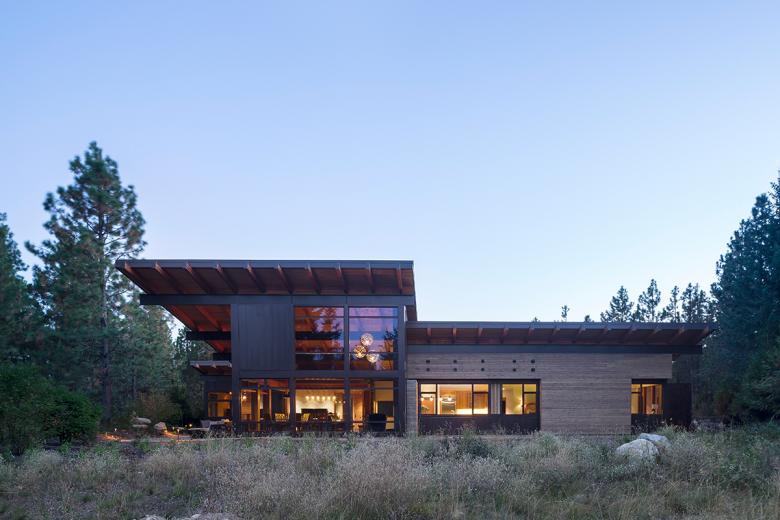Coates Design Architects
Tumble Creek Cabin
Photo: Lara Swimmer
Cle Elum is a small town located about a 90-minute drive east of Seattle. The Ellis family, having earlier commissioned Coates Design Architects to design their house on Bainbridge Island, hired the firm again for their vacation home in Cle Elum. Like the earlier house's LEED Platinum certification, the Tumble Creek Cabin incorporates sustainable design, ambitiously striving for net-zero. Coates Design Architects answered a few questions about the project.
Project: Tumble Creek Cabin, 2016
Location: Cle Elum, Washington
Client: Ed and Joann Ellis
Architect: Coates Design Architects
Design Principal: Matthew Coates
Project Architect: Brian Schroeder
Project Team: Justin Helmbrecht, Nathan Brantley, Daniel Stewart
Structural Engineer: Quantum Engineering
Landscape Architect: Patrick Lounher
Interior Designer: Melissa Anderson – All in the Details
Contractor: Brock Smith Custom Homes
Site Area: 41,450 sf
Building Area: 3,835 sf
Photo: Lara Swimmer
What were the circumstances of receiving the commission for this project?
Repeat clients Ed and Joanne Ellis first hired Coates Design Architects for their home and primary residence on Bainbridge Island — the first LEED Platinum residence in Washington. They worked again with Coates Design, which brought the same modern and sustainable design sensibilities to this vacation home intended to be a legacy piece for their extended family.
Photo: Lara Swimmer
Please provide an overview of the project.
This vacation home, designed to be net-zero, lies in a historic mining area in Washington State's Cascade Mountains. The climate is extremely cold and snowy in the winter months and scorching in the summer. Situated in a master-planned resort community, the house blends sustainable modern architecture with reclaimed rustic materials.
Photo: Lara Swimmer
What are the main ideas and inspirations influencing the design of the building?
This home was designed with the idea of creating a modern, yet rustic retreat, with an open relationship to the surrounding landscape. The home was designed to serve the family for many generations.
Photo: Lara Swimmer
How does the design respond to the unique qualities of the site?
The extreme weather conditions challenged the design team to create a comfortable environment without the use of traditional energy-consumptive cooling and heating systems. An entry vestibule and mud room conserves energy and creates an elegant entry into the main living space. This self-contained room serves double duty as a special place to welcome visitors and an air lock to keep the outdoor elements contained. Wintertime’s chilly drafts and summer’s excessive heat are kept at bay with this simple solution. Dramatic cantilevered roof planes utilize passive solar strategies by barring the summer sun and heat yet inviting in the winter sunshine. These broad overhangs also create covered outdoor space, much coveted in this climate, and a sheltered entry experience. A large board-formed concrete chimney commands attention as the focal point of the main living area. This solid mass, along with areas of concrete floor, serve also as a thermal heat sink to help maintain a stable and comfortable temperature inside.
Photo: Lara Swimmer
Was the project influenced by any trends in energy-conservation, construction, or design?
This house utilizes a high-performance building envelop enhanced with exterior continuous insulation to help moderate the internal climate year-round. These passive strategies (as well as the aforementioned entry vestibule “air-lock”, chimney mass, extended roof overhangs, etc.) are supplemented by a photovoltaic solar array paired with a Tesla Power Wall unit to reduce the house’s impact on the electrical grid. In combination with radiant floor heating, the house maintains effective internal environmental control without increasing its carbon footprint.
Photo: Lara Swimmer
What products or materials have contributed to the success of the completed building?
- High-performance rain screen building envelope with continuous exterior insulation
- Over-insulated roof beyond required Washington State Energy code minimums
- Radiant floor heating and Energy Recovery Ventilation System
- 10 kWh PV Solar Panel array, engineered for Tesla Powerwall battery backup system
- Use of rustic materials, including stone, Cor-Ten steel, and reclaimed barn wood with modern detailing
- Exposed steel-and-wood structure throughout the main spaces
- Hydronic Radiant Heat
- Heating and ventilation system can be monitored and adjusted remotely
- Massive board-formed concrete fireplace acts as a thermal mass
- LED lighting throughout
- Energy efficient aluminum-clad wood windows and doors
- Electric car charging station
- Generous overhangs control heat gain in summer and protects against winter weather
Email interview conducted by John Hill.








